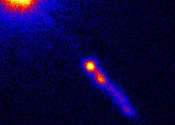Latest results from cosmic microwave background measurements
The universe was created about 13.8 billion years ago in a blaze of light: the big bang. Roughly 380,000 years later, after matter (mostly hydrogen) had cooled enough for neutral atoms to form, light was able to traverse ...









